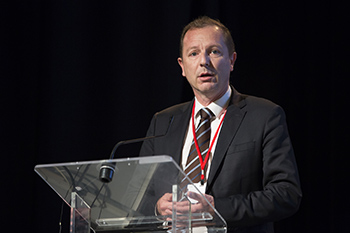Characterization, infrared imaging and modeling of aerosol dynamics for automated room decontamination
24 October 2018
M-A Cerfon, M. Rousseau, B. Lapras, S. Filali, L. Bossy, D. Salmon, C. Merienne, C. Pivot, F. Pirot Hospices Civils de Lyon, Groupement Hospitalier Edouard Herriot - Service Pharmaceutique, Place d’Arsonval - F-69437 Lyon cedex 03, France
 Objectives
Objectives
The microbial decontamination of materials used for the production of pharmaceutical sterile products might be realized by automated room decontamination device using aerosolized hydrogen peroxide (HP). The knowledge of submicron HP droplet pathway from the fogging system within the room is a key-point to appreciate the efficiency of decontamination. In the present study, the convective and diffusive transport of submicron droplets followed by adsorption-desorption process was characterized by recording particles counting (PC), temperature, relative humidity (RH) and infrared imaging (IRI) of decontamination room (DR).
Materials and methods
DR (Class ISO 8, 22 m3; 7.4 m2) was controlled with temperature (18°C), humidity ( 60% RH) and ventilation (air change rate: 32 V/h, +18 Pa to adjacent room, 0.5-µm particles/m3: < 3. 52 106, 5-µm particles/m3: < 2.9 104). After stopping air ventilation system (AVS), aqueous aerosol (Nocospray®; 66 ml; HP: 12%) was dispersed (80 m.s-1) for 6 min, then maintained in DR (1 h) and finally eliminated by AVS (20 min). PC (Beckman® HHPC 3+), temperature, RH were monitored throughout the experiment. IRI of walls was recorded by using FLIR® B60 camera.
Results and discussion
Aerosol produced a fast and stable RH increase (68% to 85%; water: 10.6 g/m3 to 13 g/m3, dew point: 13°C). Initial droplet counting (0.3-µm: 7.107/m3; 0.5-µm: 1.107/m3; 5-µm: 8.105/m3) was characterized by an exponential decrease in which decay constants (k0.3-µm: 3.10-3 min-1; k0.5-µm : 7.10-3 min-1; k5-µm: 8.10-1 min-1) were linearly dependent on droplet size. Taking into account the Brownian motion and negligible sedimentation of submicron particles, the decrease of 0.3- and 0.5-µm droplets was attributed to rapid droplet sorption on walls covered by polyethylene terephthalate film (55 µm). The kinetic of droplet sorption onto walls was modelized by fitting experimental data to Fick’s second law, for the sorption of water, in a film showing a coefficient of water diffusion (1.6 10-13 m².s-1) similar to that obtained in (1). IRI confirmed rapid and quasi-homogenous droplet sorption onto DR walls. Removal of droplets by AVS for 20 min allowed recovering initial environmental conditions whatever the droplet size. However, detection of HP traces onto walls and materials after AVS recovery confirmed that desorption of HP was incomplete and sustaining anti-microbial properties of aerosolized materials.
Conclusion
HP aerosolization for DR followed intricate dynamics in which specific surface area of droplets determined particular dual diffusion-sorption/desorption process influencing efficiency of material decontamination.
Reference
1. Dubelley F et al. Water Vapor Sorption Properties of Polyethylene Terephthalate over a Wide Range of Humidity and Temperature. J Phys Chem B. 2017;121(8):1953‑62.